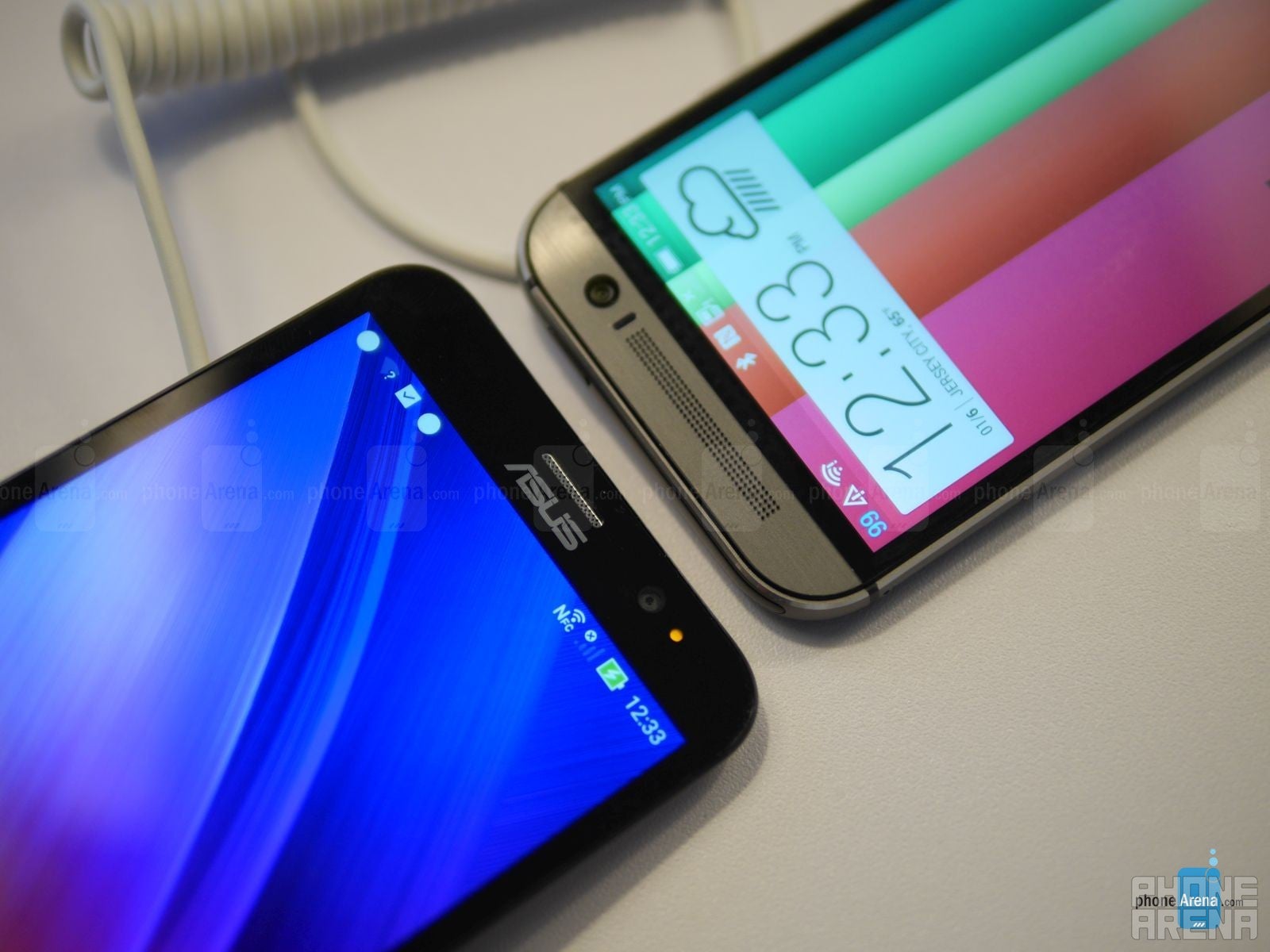Asus ZenFone 2 vs HTC One (M8): first look

Asus was one of the few smartphone manufacturers to unveil a slew of new smartphones at this year's CES at Las Vegas. Beyond a reasonable doubt, the Asus ZenFone 2 was the highlight of the show - the reason, of course, are the hefty and never-before seen on a smartphone 4GB of RAM inside (in certain versions), which make sure that this new Asus contender will have its own place in history. But how does it fare against the time-tested HTC One (M8)?
Design
Design-wise, the ZenFone 2 and the HTC One (M8) sport several important differences. Although both devices sport metal-like exterior design, only the HTC truly boast a metal build, whereas the ZenFone 2 comes with a brushed metal texture a la LG G3. The latter has also certainly inspired Asus to put the volume rocker of the ZenFone 2 at its back.
Display
Both the Asus ZenFone 2 and the HTC One (M8) put their faith into IPS LCD displays. Size, however, is a different matter - the display of the Asus proudly stands at 5.5 inches, while the One (M8) is employed with a smaller, 5-inch one. This difference, naturally, means that the HTC is more pixel-dense than the 4GB monster - 441ppi vs 403ppi. Then again, probably few will notice this difference with the naked eye, but yet, the numbers don't lie.
Interface
The faithful users of the HTC One (M8) are still waiting for Android 5.0 Lollipop to make a long-awaited appearance on the device, the adopters of the ZenFone 2 will enjoy the newest by Google right out of the box. Of course, in both cases they'll be dealing with heavily-modified version of the OS. Over in Asus' camp, that'd be an overhauled ZenUI, while the One (M8) will run the Lollipop-y version of HTC's home-brewed Sense UI.
As far as additional features are concerned, both phones surely have some aces up their sleeves. Sense UI might not be the most feature-rich take on Android out there, but it's among the more polished ones. Then again, Asus is certainly stepping its game up, as it revealed that all-new ZenUI will be graced by a slew of novel features, such as various gesture-based controls, different modes, etc.
Processor and memory
Inside the Asus ZenFone 2, one can find a 22nm Intel Atom Z3580 chipset, comprising four cores running at up to 2.33GHz. We have to mention that said chip is a 64-bit one, which will complement Android 5.0 in the finest way possible. One of the two versions of the Asus comes with 2GB of RAM, but this can't impress us as much as the 4 gigs that can be found in the most-spec'd one. In this particular aspect, the Asus shines.
In the meantime, the HTC One (M8) relies on a quad-core Snapdragon 801 chipset, doing its job at up to 2.3GHz when heavier tasks are at hand. It's certainly not among Qualcomm's top-tier selection anymore, but it is certainly not an under-powered silicon workhorse. Finally, the one (M8) flaunts "just" 2GB of RAM, half the amount of RAM that the most out-spec'd ZenFone variation has in tow, but this doesn't mean it's lagging far behind performance-wise.
The camera department is yet another department in which the Asus ZenFone 2 surpasses the One (M8), at least on paper. It sports a 13MP shooter at the rear, which overshadows the One (M8) and its 4MP UltraPixel rear camera.
Not that the latter is disappointing, no, but we generally feel that it's under-performing against most of its rivals. We can't say if this will be the case with the ZenFone 2, but the latter can potentially surpass HTC's offering.
Camera
The camera department is yet another department in which the Asus ZenFone 2 surpasses the One (M8), at least on paper. It sports a 13MP shooter at the rear, which overshadows the One (M8) and its 4MP UltraPixel rear camera.
Not that the latter is disappointing, no, but we generally feel that it's under-performing against most of its rivals. We can't say if this will be the case with the ZenFone 2, but the latter can potentially surpass HTC's offering.
Up front, both devices sport 5MP selfie cameras, which are comparable specs-wise. This doesn't mean, however, that they'll perform in a similar manner - a selfie battle will probably be tied.
The HTC One (M8) was among the best phones that arrived in 2014, but it's 2015 now, and devices like the Asus ZenFone 2 are more likely to shadow the time-tested metal warrior.
The ZenFone 2 arrived with a bang and caught us off-guard, signaling us that the current year will probably be quite dynamic.

Expectations
The HTC One (M8) was among the best phones that arrived in 2014, but it's 2015 now, and devices like the Asus ZenFone 2 are more likely to shadow the time-tested metal warrior.
The ZenFone 2 arrived with a bang and caught us off-guard, signaling us that the current year will probably be quite dynamic.
The One (M8) is at the end of its life cycle, but it will soon hand the torch to the next HTC flagship. As far as Asus is concerned, we feel that the manufacturer is on the right path - who knows, it might eventually become a household name!

Follow us on Google News


![Some T-Mobile users might be paying more starting in March [UPDATED]](https://m-cdn.phonearena.com/images/article/176781-wide-two_350/Some-T-Mobile-users-might-be-paying-more-starting-in-March-UPDATED.webp)











Things that are NOT allowed:
To help keep our community safe and free from spam, we apply temporary limits to newly created accounts: